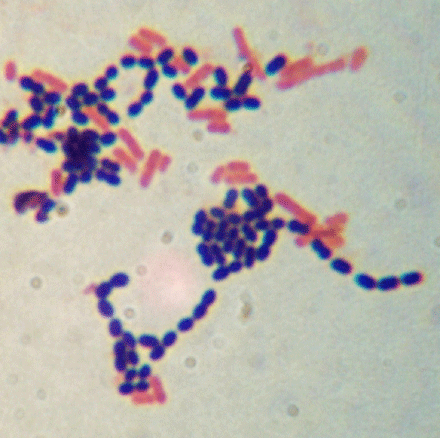So there's this miraculous drug out there called penicillin. It was discovered when Alexander Fleming noticed that a mold in one of his Staphylococcus plates was resistant to the bacteria therein. (Technically, people in the Middle Ages had been using moldy bread for treating wounds, but a lot of them got plague, so never mind.) It has since gone on to become the biggest antibiotic against Gram-positive bacteria ever. More on exactly what makes Gram-positive bacteria Gram-positive later.
You know what happens when bacteria meet human medication? They say "FUCK YOU" in big red letters. We push, and the bacteria have a vat of acid that they have reserved just for the occasion. That Staphylococcus mentioned above has become particularly problematic as of late; antibiotics like penicillin have led to a super-strain of Staph that is especially prevalent in hospitals. Sure, they're super-Staph, but they're still Staph. We can identify them and think up a new, crazy way to attack them. We know how to treat the symptoms if nothing else.
Enter the type of bacteria called Mycoplasma. They're small, notoriously hard to identify, and the only reason I know they exist is because a friend of mine is a RN. Being bacteria, they can spread almost anywhere. Their name comes from being mistaken for a fungus at first. They are nowhere close; their position is somewhere between a bacterium and a virus.
Mycoplasma were first discovered in cows, manifesting as a form of pneumonia that regular antibiotics could not cure. There have been other mycoplasmas found in other animals, such as one that gives chickens respiratory issues and spreads in their eggs (OUCH). The two most well-known types in humans are M.pneumoniae and M. genitalium. They have the shortest genomes next to nanobacteria and are less than half the size of an E.coli cell. Unlike most bacteria, which usually have Gram stains, mycoplasmas can only be 100% identified through complex methods like DNA testing.
This is because some of the common antibiotics and identification methods depend on the cell wall. Gram-positive and Gram-negative bacteria get their names from a certain type of staining method. Gram-positive bacteria show up purple under this stain. Gram-negative bacteria show up bright pink. What stain works where is determined by the bacteria's cell walls. This test also determines what antibiotics will and will not work against a given organism; some, like penicillin, attack the cell walls of Gram-positive bacteria.

Wow, our bacteria sure are gay.
Mycoplasma do not have cell walls. (They have nonetheless been grouped with G+ bacteria due to genetic relations.) They are parasites in respiratory tubes and genitalia and use their host's cholesterol to make their membranes. Wow, they must be having a blast in America; plenty of cholesterol, for sure.

Pictured: Mycoplasma heaven. Y'know, if hamburgers were alive.
Since these bacteria are parasites, it is almost impossible to develop antibiotics for them in a lab. Being a parasite means that the host has to be present as well, which is a little bit hard given the choice environments of these bacteria. Zithromax works only because it does not attack the cell wall. Antiviral herbs such as hyssop might also be effective. Until we learn how to synthesize genitalia, mycoplasmas will be at large.
If we push nature, nature shoves back. Tough cookies.
Tomorrow: SPAM! And a deadly spider NATIVE TO SUBURBIA!






No comments:
Post a Comment